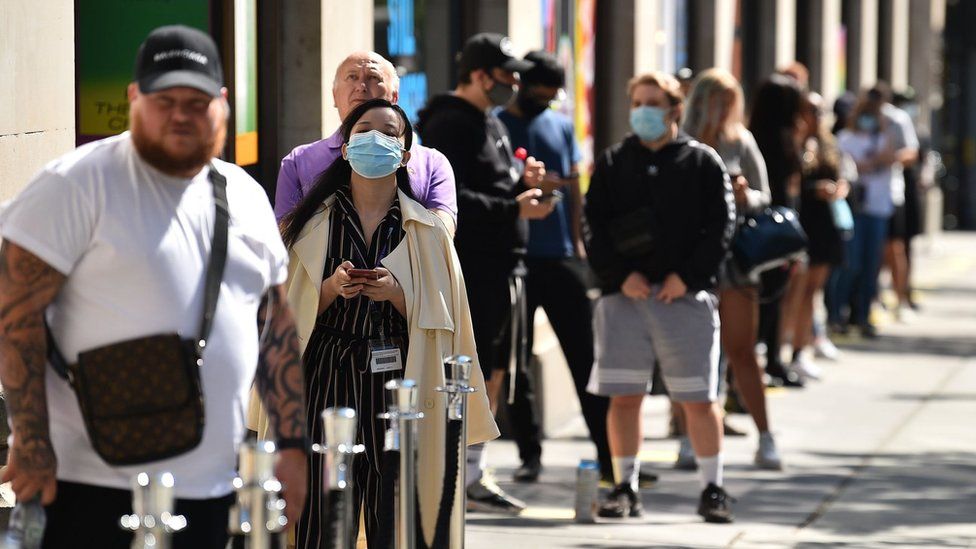Coronavirus: R number 'lower than thought' before lockdown eased in England
- Published
- comments

The rate of coronavirus infections in the community in England was significantly reduced before lockdown eased in May, according to a government-commissioned study.
Imperial College research showed there were, on average, 13 positive cases for every 10,000 people.
This means the R number was lower than thought at 0.57, the study suggests.
But the figure does not take into account infections in care homes and hospitals at the time.
Calculated using this information, the national overall reproduction number - or R - was estimated to be between 0.7 and 1 during May.
The study of 120,000 volunteers also suggested young adults aged 18 to 24 were more likely to test positive. The researchers said this could be due to young people having more social contacts over lockdown.
Health Secretary Matt Hancock said the findings showed the impact of lockdown.
He said: "As a country we have made great strides towards beating this virus but we mustn't take our foot off the pedal, and such studies will be vital as we continue to fight this virus."
The study, which is yet to be reviewed by the scientific community, provides a snapshot survey of who was infected between 1 May and 1 June and confirms what the government said it understood about reduced infections at the time.
Researchers also found people of Asian ethnicity were more likely to test positive than those of white ethnicity, while people working in care homes were at greater risk of being infected during lockdown than the general population.
And the study showed 69% of those who did test positive reported no symptoms on the day of their test or the previous week, though they may have developed symptoms later.
Those who did report symptoms complained of nausea, diarrhoea, a blocked nose, loss of smell or taste, headache, chills or fatigue.
A useful tool
Data collection has been evolving throughout the coronavirus crisis.
The suspension of community testing in March - when people outside hospitals were not offered tests - made it harder for policymakers to work out what was happening.
It took another two months for widespread laboratory and testing capacity to be established and tests rolled out to everyone.
So studies like this, with testing of a significant number of participants, are important additions to our understanding of Covid-19.
The findings tell us what was happening in May in England - that the R number was lower than we thought at the time with infection rates falling sharply.
It's important to note that this study covers community infections - and not care home or hospital cases - which explains, in part, the lower R number.
But this is broadly in line with what research by the Office for National Statistics has already told us - in other words, that lockdown had successfully forced down the number of new cases.
The Imperial College findings for June will be more interesting as they will cover a period of further easing of lockdown restrictions.
In future months, policymakers will have a useful tool as they monitor the path of the virus.
Lockdown restrictions imposed in March were initially eased in England on 13 May, when people were allowed to spend more time outdoors.
On 15 May, the reproduction number - indicating how many people are infected, on average, by someone with the virus - was estimated to be between 0.7 and 1.
In March, the R number was estimated to be as high as 4.
- SOCIAL DISTANCING: What are the rules now?
- JOBS: Can my boss force me to go to work?
- FACE MASKS: When should you wear one?
- YOUR QUESTIONS: Our experts have answers
The researchers say the work will be used as the basis of further studies to better understand what is happening to infection rates as lockdown eases.
"It's providing that baseline from which we can then assess what's happening particularly to the R value at local and regional levels as we ease out of lockdown," said Prof Paul Elliott of Imperial College London.
A further 30,000 volunteers were recruited for an upscaled study to assess the rate of coronavirus infection in England during the month of June, results of which will be published later.
Plans are currently under way for a second large-scale study, which will use antibody tests to determine how much of the general public has been infected with Covid-19 in the past.
The Imperial College study commissioned by the Department of Health considers data from volunteers in England only. Separate models are used by the devolved governments in Scotland, Wales and Northern Ireland.
- STAYING SANE: Looking after your mental health when everything is going sideways
- YOU, ME AND THE BIG C: Cancer treatment during the pandemic
- Published26 March 2021
- Published6 June 2020
- Published5 July 2023
- Published14 January 2021